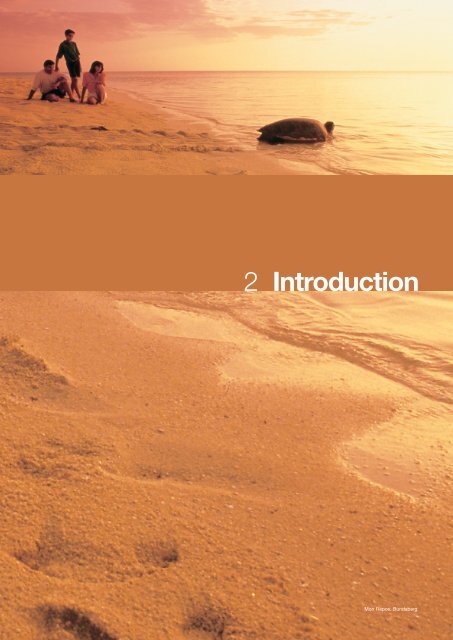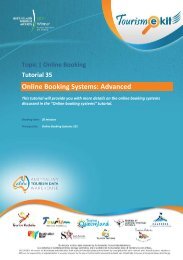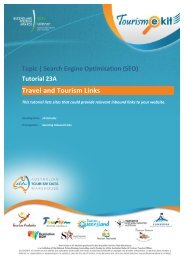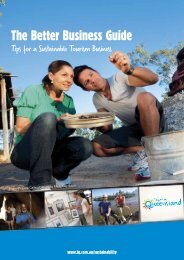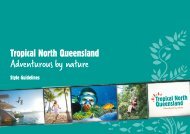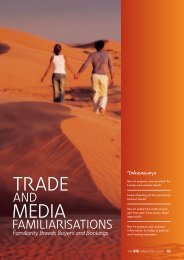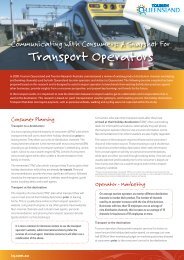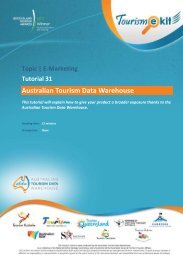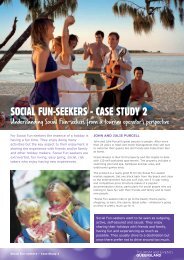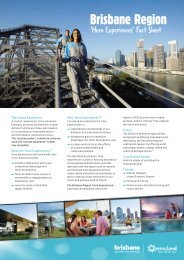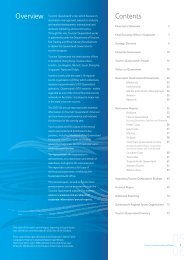QTS Chapter 2 - Introduction - Tourism Queensland
QTS Chapter 2 - Introduction - Tourism Queensland
QTS Chapter 2 - Introduction - Tourism Queensland
You also want an ePaper? Increase the reach of your titles
YUMPU automatically turns print PDFs into web optimized ePapers that Google loves.
2 <strong>Introduction</strong><br />
Mon Repos, Bundaberg
Purpose of the <strong>QTS</strong><br />
<strong>Tourism</strong> is vital for <strong>Queensland</strong>’s economic and social<br />
prosperity. <strong>Tourism</strong> is the State’s third largest export sector 1<br />
and contributes $8.4 billion to the economy. <strong>Tourism</strong> related<br />
industries employ approximately 136,000 <strong>Queensland</strong>ers. 2<br />
Defining tourism<br />
Governments and decision makers have recognised tourism<br />
as a key wealth generator and industry sector in its own right<br />
– not just an amalgam of many conventional industries that<br />
supply goods and services to tourists.<br />
<strong>Queensland</strong> is located in one of the fastest growing tourist<br />
regions of the world, forecast to achieve average annual<br />
regional tourism growth of 6.5 per cent to 2020. 3 The State,<br />
however, faces increasing competition for both domestic and<br />
international visitation from emerging destinations such as<br />
China, India, Africa and South-East Asia.<br />
Two significant issues underpin the need for the <strong>QTS</strong>.<br />
This Strategy adopts a demand-side definition of tourism<br />
developed by the World <strong>Tourism</strong> Organisation and ratified by<br />
the United Nations Statistical Commission, as follows:<br />
‘<strong>Tourism</strong> comprises the activities of persons travelling to<br />
and staying in places outside their usual environment for not<br />
more than one consecutive year for leisure, business and<br />
other purposes.’ 4<br />
2 <strong>Introduction</strong><br />
Firstly, there has been a national decline in domestic tourism.<br />
Although <strong>Queensland</strong> has fared much better than other states,<br />
the State cannot afford to be complacent, as domestic tourism<br />
represents over 75 per cent of our business.<br />
Secondly, most tourism growth over the next decade will come<br />
from increased numbers of international visitors, particularly<br />
from emerging markets. Although international visitor numbers<br />
to <strong>Queensland</strong> have increased in recent years, <strong>Queensland</strong>’s<br />
share of the national market has remained relatively stagnant;<br />
a trend that must be addressed if we are to capitalise fully on<br />
opportunities presented by inbound visitation.<br />
The <strong>Queensland</strong> tourism industry needs to adopt a strategic<br />
approach to achieving long-term sustainability through<br />
preserving existing markets, increasing visitor expenditure and<br />
enhancing product and industry development.<br />
The purpose of the <strong>QTS</strong> is to provide the vision, goals, targets<br />
and actions necessary to meet the challenges and capitalise on<br />
the opportunities available to the industry over the next 10 years.<br />
‘I highly commend the more strategic approach to be<br />
adopted towards tourism development throughout the<br />
state, with the destination focus to continue via destination<br />
management planning’. – GOLD COAST CITY COUNCIL<br />
A partnership approach to<br />
‘making the difference’<br />
<strong>Tourism</strong> has a ‘ripple effect’ throughout the economy, affecting<br />
the full supply chain from the accommodation, retail, hospitality<br />
and transport sectors to the entertainment, finance and<br />
primary industry sectors. The complex interrelationships that<br />
characterise the industry require a sophisticated and<br />
collaborative approach to planning and industry development.<br />
In developing the <strong>QTS</strong>, a strong partnership has been forged<br />
between the <strong>Queensland</strong> Government and the tourism<br />
industry. The Strategy provides actions for both government<br />
and industry, with performance and accountability measures<br />
applicable to both partners.<br />
The <strong>Queensland</strong> <strong>Tourism</strong> Strategy Steering Committee has<br />
focused on identifying policy areas where a tangible and<br />
measurable difference can be achieved. This is articulated in<br />
the targets developed to measure performance against the<br />
actions in the Strategy.<br />
‘This assiduous commitment to involving industry in the<br />
development of the 10 year vision for sustainable tourism<br />
has helped produce a robust framework for the industry<br />
and government to work together over the coming decade’.<br />
– TOURISM AND TRANSPORT FORUM<br />
1 Office of Economic and Statistical Research, 2004-05 Annual Economic Report of the <strong>Queensland</strong> Economy.<br />
2 Office of Economic and Statistical Research, The Contribution of International and Domestic Visitor Expenditure to the <strong>Queensland</strong> Economy 2003-04.<br />
3 World <strong>Tourism</strong> Organisation, <strong>Tourism</strong> 2020 Vision, www.world-tourism.org/facts/menu.html (website accessed 20 April 2006).<br />
4 World <strong>Tourism</strong> Organisation, Recommendations on <strong>Tourism</strong> Statistics 1994, www.world-tourism.org/<br />
9
2 <strong>Introduction</strong><br />
A triple-bottom-line perspective<br />
In taking a triple-bottom-line approach to tourism development,<br />
the aim is to find an appropriate balance between environmental,<br />
social and economic outcomes. This is reflected in the goals,<br />
themes and actions detailed in this Strategy.<br />
Economic goals<br />
Increase visitor<br />
expenditure<br />
Increase business<br />
profitability<br />
Increase employment<br />
opportunities<br />
Spread benefits<br />
across destinations<br />
Environmental outcomes<br />
<strong>Queensland</strong>’s natural environment is a significant tourism<br />
asset. Increasingly, the tourism and conservation sectors are<br />
recognising synergies of interest and are collaborating to achieve<br />
sustainable tourism and environmental outcomes. This trend is<br />
reflected in the growing relationship between public sector<br />
protected area managers and the tourism industry. A recent<br />
example is the role the tourism industry has played in supporting<br />
the sustainable management of the Great Barrier Reef.<br />
<strong>Tourism</strong> provides positive environmental benefits in two key ways:<br />
by providing economic incentives to protect or rehabilitate<br />
natural areas; and<br />
by increasing community appreciation of the natural<br />
environment.<br />
Social goals<br />
Preserve culture & heritage<br />
Improve services & infrastructure<br />
Improve quality of life<br />
Involve community<br />
<strong>Tourism</strong><br />
sustainability<br />
Environmental goals<br />
Protect natural assets<br />
Manage usage & impacts<br />
Inform & educate people<br />
Build strong partnerships<br />
Diagram 1: Triple-bottom-line sustainability<br />
Ball Beach, Mackay<br />
Theme five, Natural environment and culture, includes a range<br />
of actions to enhance the relationship between the tourism<br />
industry, protected area managers and the conservation sector<br />
and build a sustainable competitive advantage for the<br />
<strong>Queensland</strong> tourism industry.<br />
Critically, as a means of driving environmentally and socially<br />
sustainable levels of visitation, the <strong>QTS</strong> identifies goals and<br />
targets related to visitor expenditure rather than to visitor<br />
numbers. Key <strong>QTS</strong> actions include the development of<br />
indicators of environmental sustainability for the tourism sector<br />
and measures to identify the impacts of climate change.<br />
Economic outcomes<br />
The economic benefits of tourism are widely recognised. In<br />
addition to its direct contribution to <strong>Queensland</strong>’s Gross State<br />
Product (5.8 per cent) 5 tourism is a strong driver of the<br />
multiplier effect throughout the supply chain. <strong>Tourism</strong> provides<br />
an indirect economic stimulus across many industry sectors<br />
and with the movement of visitors, benefits are dispersed to<br />
communities throughout <strong>Queensland</strong>.<br />
The <strong>QTS</strong> expenditure goals reflect a commitment to increase<br />
the economic benefits of tourism for <strong>Queensland</strong>. The Strategy<br />
focuses on increasing visitor expenditure. The ‘preferred visitor’<br />
strategies contained in theme four, Developing and marketing<br />
a <strong>Queensland</strong> style visitor experience, support this approach.<br />
5 Office of Economic and Statistical Research, The Contribution of International and Domestic Visitor Expenditure to the <strong>Queensland</strong> Economy 2003-04.<br />
10<br />
<strong>Queensland</strong> <strong>Tourism</strong> Strategy – November 2006
Birdsville Hotel, Birdsville<br />
Social outcomes<br />
<strong>Tourism</strong> has both positive and negative effects on society.<br />
A key objective of this Strategy is to foster greater community<br />
involvement in setting desirable growth outcomes for tourism<br />
and promoting awareness of the benefits of tourism.<br />
Community engagement in planning the future of tourism is<br />
critical to creating sustainable communities.<br />
The role of tourism in the community is recognised in the<br />
Strategy’s fourth goal. The social benefits of carefully-planned<br />
tourism activities include:<br />
a growth in demand for new infrastructure and services<br />
benefiting visitors and locals;<br />
a growth in job opportunities that can sustain marginal<br />
communities;<br />
an improvement in community cohesiveness through<br />
partnerships built between local people, organisations and<br />
businesses; and<br />
opportunities for Indigenous communities to improve their<br />
quality of life through appropriate Indigenous tourism<br />
activity, based on unique and contemporary experiences.<br />
Theme one, Coordination, partnerships and community<br />
engagement, and theme two, Investment, infrastructure and<br />
access, include actions aimed at creating an inclusive regional<br />
planning mechanism for the tourism industry and raising<br />
community awareness of the benefits of tourism.<br />
2 <strong>Introduction</strong><br />
Making <strong>Queensland</strong> more accessible<br />
The tourism industry has a legal, economic and social<br />
responsibility to ensure travel is available to all members<br />
of the community. More than 3.6 million people in Australia<br />
have a disability, or almost 19 per cent of the population. 6<br />
With Australia’s ageing population, this figure is likely to<br />
increase in the next decade. The <strong>Queensland</strong> Government<br />
Strategic Framework for Disability details the obligations<br />
and responsibilities of all sectors to the disabled.<br />
The <strong>QTS</strong> provides a framework to ensure that <strong>Queensland</strong>’s<br />
tourism industry retains its position as a leading destination<br />
in providing the highest level of accessibility to tourism<br />
services, products and experiences.<br />
Access to public premises, the provision of goods, services<br />
and facilities, and accommodation are governed by a range<br />
Sea World, Gold Coast<br />
of federal, state and local government legislation including<br />
the Commonwealth Disability Discrimination Act 1992, the<br />
Disability Services Act 2006, the Building Code of Australia,<br />
and local government town plans.<br />
The <strong>Queensland</strong> Government has a key role in influencing<br />
the tourism industry to meet the demand for accessible<br />
tourism services, products and experiences. <strong>Tourism</strong><br />
<strong>Queensland</strong> has recently undertaken a number of initiatives<br />
to address the needs of people with disabilities including:<br />
undertaking consumer research on accessibility, the<br />
ageing population and people with disabilities, and<br />
establishing an Accessible <strong>Tourism</strong> Reference Group<br />
to discuss the implications of the research and formulate<br />
an action plan to address supply and demand issues.<br />
This may lead to the development of a national website<br />
providing information about the accessibility of tourist<br />
destinations.<br />
A key recommendation of the <strong>QTS</strong> is to provide information<br />
to assist industry to cater for disabled visitors. Actions<br />
include reviewing and updating the Accessible <strong>Queensland</strong><br />
Guide, completing an Accessibility Research Program to<br />
inform product development better and providing clear<br />
information to industry on their legal obligations regarding<br />
accessible tourism. Disability Services <strong>Queensland</strong> will assist<br />
in delivering on these actions.<br />
6 Disability, Ageing and Carers, Summary of findings 1999.<br />
11
Policy and planning context<br />
Wherever possible, the <strong>Queensland</strong> <strong>Tourism</strong> Strategy Steering<br />
Committee has sought to develop strategies and actions that<br />
are consistent with, or can add value to, existing industry plans.<br />
The Strategy seeks to add value to and influence the following<br />
key policies:<br />
National context<br />
The <strong>Tourism</strong> White Paper, A Medium to Long Term Strategy<br />
for <strong>Tourism</strong>, details the Australian Government’s tourism policy<br />
and contains coordinated initiatives to ‘help better prepare the<br />
Australian tourism industry against future industry shocks by<br />
making it more robust, flexible and attuned to sustainability’. 7<br />
A <strong>Tourism</strong> Collaboration Intergovernmental Arrangement with<br />
state and territory governments provides a mechanism for<br />
implementation and coordination.<br />
Commonwealth<br />
Minister for Small Business and <strong>Tourism</strong><br />
Department of Industry<br />
<strong>Tourism</strong> and Resources<br />
Australian Government<br />
<strong>Tourism</strong> White Paper<br />
<strong>Tourism</strong> Collaboration<br />
Intergovernmental<br />
Arrangement<br />
<strong>Tourism</strong><br />
Ministers’<br />
Council<br />
Australian<br />
Standing<br />
Committee<br />
on <strong>Tourism</strong><br />
<strong>Tourism</strong><br />
Australia<br />
State context<br />
2 <strong>Introduction</strong><br />
The <strong>QTS</strong> will make a significant contribution to the following<br />
<strong>Queensland</strong> Government priorities:<br />
managing urban growth and building <strong>Queensland</strong>’s regions;<br />
protecting the environment for a sustainable future; and<br />
growing a diverse economy and creating jobs.<br />
The <strong>QTS</strong> Steering Committee has sought alignment with the<br />
broader objectives of the <strong>Queensland</strong> Government’s Smart<br />
State Strategy by ensuring that the <strong>QTS</strong> provides a policy<br />
direction for the tourism industry that is focused on the future,<br />
innovative and reflective of changes in technology.<br />
State<br />
Minister for <strong>Tourism</strong><br />
Department of <strong>Tourism</strong>,<br />
Fair Trading and Wine<br />
Industry Development<br />
<strong>Queensland</strong> <strong>Tourism</strong><br />
Strategy<br />
<strong>Tourism</strong><br />
<strong>Queensland</strong><br />
The <strong>Queensland</strong> Government, through the Growing <strong>Tourism</strong><br />
Strategy, recognised that tourism required coordination at all<br />
levels of government and across all government departments.<br />
In building on and replacing the Growing <strong>Tourism</strong> Strategy, the<br />
<strong>QTS</strong> extends the whole-of-government approach to provide<br />
both central and regional government coordination and<br />
effective industry engagement.<br />
Regional and local<br />
Regional <strong>Tourism</strong> Organisations<br />
Local <strong>Tourism</strong> Organisations /<br />
Local Government<br />
Destination Management Plans<br />
Destination Action Plans<br />
The Strategy aims to ensure that the tourism industry is<br />
consistently recognised in policy development across government<br />
and particularly in key planning documents such as the:<br />
<strong>Queensland</strong> Skills Plan;<br />
Education and Training Reforms for the Future;<br />
Regional Growth Management Frameworks such as the<br />
SEQ Regional Plan, the eight existing regional plans outside<br />
the SEQ region, and future regional plans;<br />
Blueprint for the Bush;<br />
<strong>Queensland</strong> Wine Industry Development Strategy;<br />
Partnerships <strong>Queensland</strong>;<br />
Roads Implementation Program;<br />
Community Engagement Improvement Strategy;<br />
<strong>Queensland</strong> Government Strategic Framework for Disability;<br />
Integrated Regional Transport Plans; and<br />
Shared Regional Economic Development Vision Statements<br />
developed under the Leading Smart Regions initiative.<br />
The <strong>QTS</strong> provides the framework to strengthen and capitalise<br />
on the linkages between the tourism structures and policies<br />
within Australia, as outlined in diagram 2.<br />
<strong>Tourism</strong> Industry<br />
Including tourism associations<br />
e.g. TTF, ATEC, QTIC etc.<br />
Diagram 2: Structure of tourism strategies and policies<br />
Regional context<br />
Destination management is a critical foundation for regional<br />
tourism planning and to be successful, requires a strong<br />
partnership between all stakeholders within the tourism network.<br />
This Strategy builds on the Destination Management Plans<br />
to reinforce the commitment to the destination management<br />
framework by creating a collaborative regional tourism planning<br />
mechanism. Theme one, Coordination, partnerships and<br />
community engagement, provides a detailed overview of<br />
the regional implementation process and network.<br />
7 Department of Industry, <strong>Tourism</strong> and Resources, The <strong>Tourism</strong> White Paper.<br />
12<br />
<strong>Queensland</strong> <strong>Tourism</strong> Strategy – November 2006
Destination management – growing <strong>Queensland</strong>’s regions<br />
‘Coming together is a beginning; keeping together is<br />
progress; working together is success.’ – HENRY FORD<br />
Destination management is a strategic approach that coordinates<br />
stakeholders in the planning, development, marketing and<br />
application of resources to grow tourism in a destination for<br />
the benefit of the tourism industry and the wider community.<br />
For destination management to work, there needs to be a<br />
strong emphasis on both planning and implementation.<br />
A Destination Management Plan (DMP) is a strategic plan<br />
for tourism in a destination. It outlines the vision, goals and<br />
strategies for the destination over the next three years.<br />
Tangalooma Wild Dolphin Resort, Moreton Island<br />
The destination management approach recognises that<br />
<strong>Queensland</strong>’s destinations are all different. The DMP<br />
illustrates how the destination can capitalise on these<br />
differences and ensures there is alignment in tourism<br />
development and marketing.<br />
DMPs were first developed in 2003-04, and to ensure<br />
currency and relevancy they are updated regularly with the<br />
latest research, destination information and tourism trends.<br />
The plans also undergo a complete strategy review every<br />
three to five years to maintain relevance. These plans can<br />
be accessed at www.tq.com.au.<br />
2 <strong>Introduction</strong><br />
Analyse the global<br />
operating environment<br />
Monitor and evaluate<br />
performance<br />
Implement the strategies<br />
Destination<br />
Management<br />
Planning<br />
Identify strategies that<br />
will contribute to the<br />
achievement of the vision<br />
Analyse the situation<br />
in the destination<br />
Define the vision for the<br />
destination and identify<br />
key strategic issues<br />
Diagram 3: Destination management<br />
13


